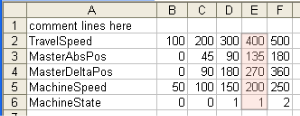![]()
 Function
Function![]() A function calculates a result according to the current value of its inputs. A function has no internal data and is not linked to declared instances. - Apply the values of a column from a recipe file.
A function calculates a result according to the current value of its inputs. A function has no internal data and is not linked to declared instances. - Apply the values of a column from a recipe file.
Inputs
|
Input |
Data Type |
Range |
Unit |
Default |
Description |
|---|---|---|---|---|---|
|
FILE |
STRING |
|
|
|
Path name of the recipe file (.CSV or .RCP). Must be a constant value. |
|
COL |
DINT |
|
|
|
Index of the column in the recipe (0 (zero) based). |
Outputs
|
Output |
Data Type |
Range |
Unit |
Description |
|---|---|---|---|---|
|
OK |
BOOL |
|
|
|
Remarks
- The FILE input is a constant string expression specifying the path name of a valid .CSV or .RCP file.
- If no path is specified, the file is assumed to be located in the project folder.
- CSV files are created using Excel or Notepad.
- RCP files are created using an external recipe editor.
- In CSV files, the first line must contain column headers, and is ignored
during compiling.
- There is one variable per line.
- The first column contains the symbol of the variable.
- Other columns are values.
- If a cell is empty, it is assumed to be the same value as the previous (left
side) cell.
- If it is the first cell of a row, it is assumed to be null (0 or FALSE or empty string).
Example of CSV file with five variables and five set of values
comment lines here
TravelSpeed;100;200;300;400;500
MasterAbsPos;0;45;90;135;180
MasterDeltaPos;0;90;180;270;360
MachineSpeed;50;100;150;200;250
MachineState;0;0;1;1;2
-
-
For your CSV file to be valid, ensure the data are separated with semicolons (and not commas).
Usage in a FFLD program where column 3 is selected
Column 3 corresponds to column E in the Excel sheet because this parameter is 0 based
Result displayed in the Dictionary when the application is running
@COLNAME=Col3 Col4
@SIZECOL1=100
@SIZECOL2=100
@SIZECOL3=100
@SIZECOL4=100
bCommand
tPerio
bFast
Blink1
test_var
bOut
@EXPANDED=Blink1
-
-
Recipe files are read at compiling time and are embedded into the downloaded application code.
This implies that a modification performed in the recipe file after downloading is not taken into account by the application.
FBD Language
FFLD Language
- In the FFLD language, the operation is executed only if the input rung (EN) is TRUE.
- The output rung is the result of the function.
- The function is executed only if ApplyRecipe is TRUE.
IL Language
Op1: LD"Ladder diagram" Ladder logic is a method of drawing electrical logic schematics. It is now a very popular graphical language for programming Programmable Logic Controllers (PLCs). It was originally invented to describe logic made from relays. The name is based on the observation that programs in this language resemble ladders, with two vertical "rails" and a series of horizontal "rungs" between them 'MyFile.rcp'
ApplyRecipeColumn COL
ST"Structured text" A high-level language that is block structured and syntactically resembles Pascal OK
ST Language
OK := ApplyRecipeColumn ('MyFile.rcp', COL);










